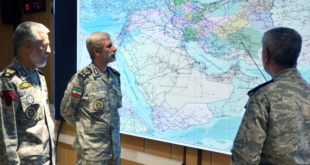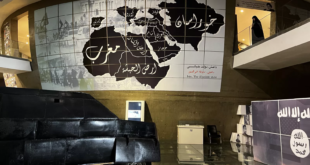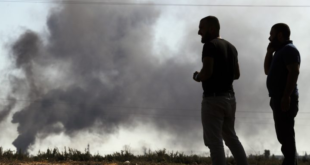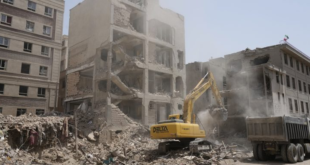BAGHDAD (AP) — Breaking down in tears, a Kurdish woman testified Tuesday in the genocide trial of Saddam Hussein, describing how foul smoke billowed across her village, blinding residents, in a 1987 poison gas attack and how her male relatives disappeared at a prison camp.
Najiba Khider Ahmed was one of two survivors who took the stand in the second day of Saddam’s new trial over the Anfal campaign, a military sweep across northern Iraq in which tens of thousands of Kurds were killed and hundreds of villages levelled.
As the prosecution began to set up its case with brutal accounts of children dying in gas attacks and men dragged away never to be seen again, the outlines of a likely defence strategy began to emerge.
Saddam and his lawyers repeatedly accused the survivors of being coached in their testimony. At the same time, two of his co-defendants insisted that Anfal did not target civilians and aimed only to wipe out Kurdish fighters they said were helping Iran in the bloody Iran-Iraq war of the 1980s.
Ahmed and fellow survivor Ali Mostafa Hama described the April 16, 1987 bombardment of Sheikh Wasan and the nearby village of Basilan, believed to be the first time Saddam’s regime used chemical weapons against Iraqi citizens. After the assault, residents were rounded up into prison camps, and most of the men taken away on trucks and later executed, they said.
“I saw eight to 12 jets … There was greenish smoke from the bombs,†Hama said. “It was as if there was a rotten apple or garlic smell minutes later. People were vomiting … we were blind and screaming. There was no one to rescue us. Just God.†Hama, wearing a traditional Kurdish headdress, said he saw a newborn infant die during the bombardment. “The infant was trying to smell life, but he breathed in the chemicals and died,†he said, speaking in Kurdish with an Arabic translator.
The 1987-1988 military offensive was so notorious among the Kurds that it entered the vocabulary. Repeatedly, Ahmed and Hama referred to relatives who had been “anfalised†— disappeared only to be found later, if at all, in the mass graves left by the campaign.
Ahmed, wearing a black headscarf, said she was blinded for days by the gas. At the prison camp where she was kept for nine days afterward, her 3-year-old son was taken away.
“They anfalised him,†she wept. “May God anfalize them.†She said her niece also disappeared.
All the men were taken away on trucks from the camp, the 41-year-old woman said. “My brother started screaming ‘Fatma, Fatma, don’t leave my hand’ — that was his wife,†she said, weeping. “So they took him, kicked him, beat him, and I didn’t see him after that.†Saddam and his six co-defendants could face execution by hanging if convicted in the Anfal case. Saddam and his cousin, Ali Hassan Majid, a Baath Party leader who allegedly organised Anfal, are charged with genocide — considered the toughest charge to prove since its requires showing their intention was to exterminate part of an ethnic group.
Saddam and Majid also face charges of crimes against humanity and war crimes, as do their co-defendants, most of whom are former military figures.
Saddam is still waiting a verdict on October 16 in the first case against him — the nine-month-long trial over the killings of 148 Shiites in a 1980s crackdown on the town of Dujail.
In that case as well, he and seven other co-defendants could face the death penalty.
The Anfal trial is likely to take months as well. The campaign was on a far greater scale than the Dujail crackdown, with anywhere from 50,000 to 180,000 Kurds killed. Prosecutors plan to bring up to 75 witnesses and extensive documents from the former regime, as well as evidence from mass graves.
So far, however, the trial has seen none of the shouting and disruptions that plagued the Dujail trial and caused extensive delays.
Before the survivors testified, two of Saddam’s co-defendants addressed the court and insisted Anfal was targeted at Iranian troops and allied Kurdish fighters in northern Iraq.
“The goal was to fight an organised, armed army … the goal was not civilians,†said Sultan Hashim Tai, who was the commander of Task Force Anfal and head of the Iraqi Army 1st Corps.
He said civilians in the areas where Anfal took place were “safely transported†to other areas, including the northern city of Kirkuk.
The orders in the campaign were “to prevent the Iranian army from occupying Iraq at whatever price,†said Tai, who later served as defence minister until the fall of Saddam’s regime in 2003. “I never turned a blind eye to any violation.†Sabir Douri, the head of Military Intelligence at the time of Anfal, said “the Iranian army and Kurdish rebels were fighting together†against the Iraqi army and that Anfal aimed to clear northern Iraq of Iranian troops.
“You will see that we are not guilty and that we defended our country honourably and sincerely,†Douri said.
Throughout the survivors’ testimony, Saddam and the defence lawyers insisted the two had been coached — with one lawyer asking how Ahmed, who said she was illiterate, could specify that Russian-made Sukhoi warplanes carried out the bombardment.
“Who told you to say these things?†Saddam asked Hama at one point.
Defence lawyers also grilled the two survivors on whether Kurdish fighters were operating in their villages. Hama acknowledged that the fighters, known as peshmerga, would come in and out of Basilan.
“Yes, some villagers were helping the peshmerga. But that doesn’t give you the right to attack them with chemical weapons,†prosecutor Munqith Faroon interjected.
Ahmed and Hama were testifying as plaintiffs in the case.
The trial was adjourned until Wednesday, when more plaintiffs will be heard.
Ahmed told the court she suffered burns in the chemical attack. She said she had two pregnancies afterward — the baby in the first was born with skin peeling off, and the second miscarried, born with malformed limbs, which she blamed on the gas.
She and other residents fled to caves the morning after the attack, then made their way to a nearby village, from which the military took them to the prison camp, she said.
The camp, she said, had “the smell of dead dogs …
During those nine days, we saw the apocalypse. Even Hitler didn’t do this.†After her release, she returned to her home village, where her husband’s father died in the initial gas attack. “All the animals were blind and dead. The stench was everywhere,†she said.
“Saddam Hussein used to shout about ‘the Iraqi People,‒ she told the court. “If we were his people, why did he bomb us with all sorts of weapons?â€
 Eurasia Press & News
Eurasia Press & News



